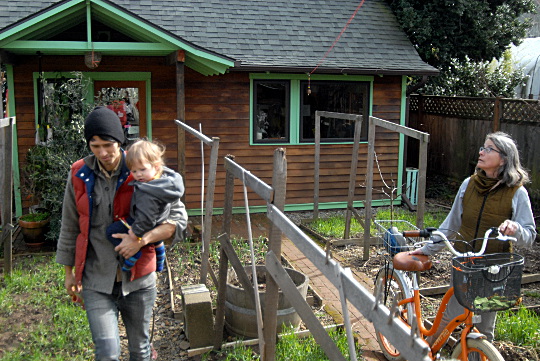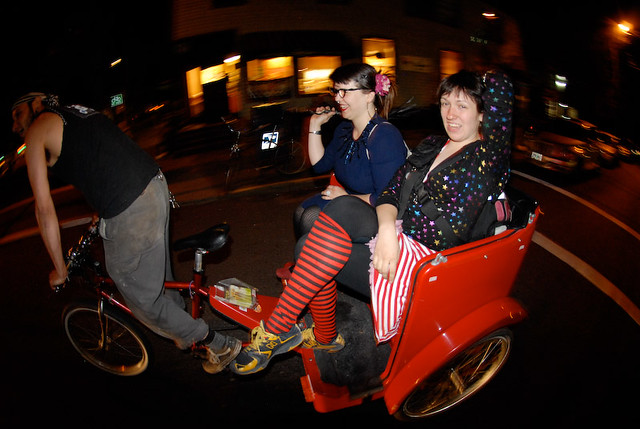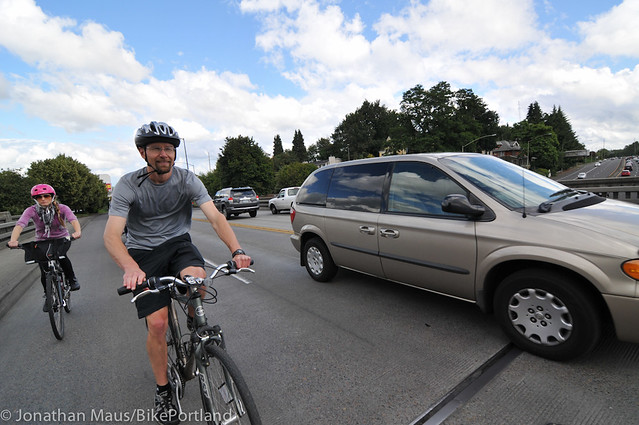A flurry of end-of-year activity at Portland City Hall Wednesday led to changes in three different stories we’ve been tracking on BikePortland.
With Commissioner Amanda Fritz playing a key role in all three votes, the council agreed to delay changes to pedicab rules that would have required pedicab operators to hold driver’s licenses and have a year of continuous driving experience; to require a one-time “defensive driving” training for taxi, Lyft and Uber workers rather than retrainings every two years; and to allow small accessory dwelling units to be built near the edge of properties as long as they’re no larger than the garages that have long been allowed near property lines.
“Worst of all is the appalling disregard in this ordinance for pedestrians, cyclists, and other motorists.”
— Amanda Fritz
Fritz and her colleagues Nick Fish and Dan Saltzman had pushed on Nov. 24 to postpone the effective date of new pedicab rules until the pedicab industry could confer with city staff. An amendment to this effect by Fish was approved unanimously then, and was (the city said) reflected in the code approved today.
On taxi safety, Fritz and Fish cast votes against the new rules, with Fritz citing “appalling disregard in this ordinance for pedestrians, cyclists, and other motorists injured” by drivers of Lyft, Uber and other so-called “transportation network companies.” The ordinance passed 3-2.
And on backyard homes, Fritz cast a lone vote against allowing garage-sized residences to be built without five-foot setbacks from property lines. She was outvoted 4-1.
Here’s what happened in a bit more detail:
Pedicabs
As we reported Nov. 18, Portland’s effort to rewrite its code for “private for-hire transportation” was prompted by the illegal arrival of Uber last spring. It resulted in the city hastily rewriting its rules for pedicabs without notifying local operators that it was doing so.
Among the proposed rules: pedicab operators would have been required to hold driver’s licenses and have “at least one year’s worth of continuous driving experience in a United States jurisdiction” before certification as a pedicab driver.
Even city staffers overseeing the code rewrite didn’t seem to be aware that this was what the code said. In this exchange with Fritz from a Nov. 24 hearing, Novick advisor Bryan Hockaday said “we did not intend to have any changes” for pedicab companies before conceding that apparently changes had been made.
Advertisement
Fritz, Fish and Saltzman persuaded the council to preserve the status quo for pedicabs and also for non-emergency medical transport companies, which are also covered but were not consulted about the rewrite.
Because of the difficulty of revising code on a tight deadline, the council left the proposed code language in place, but PBOT spokesman John Brady said in an email Wednesday that the council had included a clause saying that the new rules for pedicabs and NEMT companies didn’t apply.
Taxi, Lyft and Uber safety
As we reported Nov. 5, Portland’s new rules for taxis and transportation network companies require drivers to complete a “defensive driving” course. The city describes this requirement (which isn’t common on Uber or Lyft drivers around the country) as part of its Vision Zero effort.
But that provision will replace a stiffer one that currently applies to taxis.
“The problem is it’s a one-and-done training requirement, instead of the current mandate for taxi drivers to do a defensive driving course every two years,” Commissioner Fritz explained in an email Wednesday. “Also, the TNCs get to start driving then take the test in 30 days, despite testimony that more accidents happen when drivers are new.”
Fritz also took issue with the fact that the city requires only $50,000 of liability insurance coverage for TNC drivers when they are on their way to or from a job.
“I am baffled as to why any of you would consider your own life, or that of the person you love most in the entire world, to max out in value at $50,000, less than half of one year of our salaries,” said Fritz, whose husband was killed last year in a multi-vehicle collision on Interstate 5. The Mercury has the full text and video of her emotional address.
Fish voted with Fritz against the new rules. Transportation Commissioner Steve Novick voted for them but said he doesn’t think the $50,000 limit is acceptable but hopes to fight it in the state legislature instead of city council.
“Uber and Lyft have made it clear that if any jurisdiction tried to depart from this agreement, they intend to declare war,” Novick said. “If you’re going to pick a fight with a $50 billion company, you’re probably smart to look around for some allies. So I’m going to do that.”
Backyard homes

(Photo: M.Andersen/BikePortland)
As we reported Nov. 20, Fritz is not a fan of a proposal to remove a five-foot setback that applies to small homes but not to garages of the same size.
City code has long allowed structures to be built in R-7, R-5 and R-2.5 zones that are no more than 15 feet tall at the peak and 10 feet tall by 24 feet wide on any wall close to a property line, as long as they are “garages” designed to hold a motor vehicle.
A code change discussed for most of this year proposed to remove that special status for car storage, allowing structures like backyard rec rooms or large bike sheds in similar buildings. Fritz said she supported those uses but not another scenario: if the home included a bedroom and a kitchen sink, thus qualifying it as a detached accessory dwelling unit.
Fritz said she’d asked the people at two recent community meetings about the measure and “by a 20-1 margin people do not, in general, support this. I have given both arguments for and arguments against, as I read them in my emails, and did not state my own preference, and it was quite stunning how many people are quite concerned about this. And I believe that it’s going to have backlash against accessory dwelling units.”
She predicted “an explosion of these built as Airbnbs.”
Mayor Charlie Hales, the only other council member to comment on the issue, said he was “sensitive to the concerns” raised by Fritz but said there was “such demand for this kind of housing in the city that we should try to make this work.” He, Fish, Saltzman and Novick all voted for it.
— Michael Andersen, (503) 333-7824 – michael@bikeportland.org








Thanks for reading.
BikePortland has served this community with independent community journalism since 2005. We rely on subscriptions from readers like you to survive. Your financial support is vital in keeping this valuable resource alive and well.
Please subscribe today to strengthen and expand our work.
I lovehate Amanda Fritz. Don’t always agree with her but I appreciate what she says and the way she says it.
and she has a nice plaid bathrobe
have you ever made this kind of comment about novick or hales?
Hales has lousy taste in bathrobes. Don’t ask me how I know. 😉
The pajama bottoms as street ware have surfaced as “a thing” but neither of our representatives have gone that casual. I would not hesitate to swing for the fence if either of those male politicians tossed me such a softball. I am not above fashion victim blaming
Nice.
Agreed. She seems to have a blind spot regarding certain elements of density and affordability, but she is the only one on the council who I can honestly say is not bought by outside interests.
As for the concern about ADUs being used as airbnbs, maybe the only thing to do here is just let this market saturate. If everyone runs an Airbnb out of their house, eventually the oversupply makes it less lucrative. Then those property owners can rent the units out to more conventional tenants. I might have the economics of this all wrong, of course.
Every ADU used as an Airbnb is one less rental unit available. Of course it’s not quite as simple as that, but it is true that a fair bit of rental stock that is tied up serving the Airbnb market.
I believe Airbnb consumes affordable housing to the detriment of renters. It reduces density. It’s a great way to experience a city, but it incurs some real costs.
I would consider existing ADUs and to-be-built ADUs separately.
An existing ADU can be used for long term (monthly rental, family) or short term housing (AirBNB). Some homeowners who choose to do AirBNB might not be willing to do a long term rental (an AirBNB visitor pays much more, is gone in a few days, doesn’t require a full kitchen/laundry, and you can choose when to rent and when to use the ADU for your friends/family or leave it vacant – it is lucrative and flexible; a long term renter is there all the time, if you don’t like them it is some hassle to evict them, and they pay much less – less lucrative, less flexible). But, yeah, I expect many existing ADUs that are rented on AirBNB are being removed from the pool of long term housing. Right now, about 1,500 apartment or ADUs in Portland (being used for AirBNB). So the pool of long tern housing stock is being reduced by something less than 1,500; maybe 1,000 units?
A to-be-built ADU is a different story, because it is a large investment (figure $60-100K for a small one, like one-car garage size – 200-300 sq ft). It may not be attractive to spend $80K of your after tax income to get $6K/year ($500/mo) as a long term rental. But if you can get $12-15K/yr on AirBNB, then you might spend the money to build the thing. That’s an ADU that wouldn’t have been built if not for the AirBNB opportunity, and thus is not an ADU removed from the pool of long term housing stock. Later, it might become added to that pool of long term housing – a new person might buy the house, the original person might get tired of the work required for an AirBNB unit, a family member might move in.
In general, I think getting more ADUs built is a good thing, whether they are initially used for long term housing or for AirBNB. AirBNB brings its own benefits to Portland: tourism revenue and jobs, income for homeowners, construction jobs. Certainly, whether an ADU is being used for long term housing or for AirBNB, it is bringing more benefits than a garage or an empty bit of yard.
You may be right about some ADUs, but nearly 100% of the Airbnb units I have rented (in other cities), or know of in my neighborhood, would be rented out long term if not for Airbnb.
I’m not a heavy Airbnb user, nor do I know of a ton of units locally, so this may not be representative. But I can say with certainty that fewer families and individuals are able to live in my close-in neighborhood because of Airbnb.
You make some arguments that this could be seen as a good thing (i.e. more money flowing into the neighborhood), and I won’t deny there is some positive aspect to it. It all depends on how you weigh tourism vs. density, and short-term vs. long-term.
It may be that AirBNBs represent units that could otherwise be rented out conventionally, but this thread isn’t about whether we do or do not allow Airbnb to operate here. It’s about whether or not we allow more ADUs. I agree with Peejay this is because there’s a severe shortage of beds in Portland, hotel or otherwise, and the solution is to alleviate the shortage in multiple ways.
Even if most of these ADUs end up rented out as Airbnbs, not all of them will, so some will become rental units. And the more ADUs built, the smaller the proportion that become Airbnb rentals, and the larger the proportion that become conventional rentals. Simple microeconomics.
For what its worth, I made a very rough guesstimate of how much money the 1500 apartment/ADUs used for AirBNB bring to Portland. Assume 180 days/yr x ($125 rent + $150 other spend) x 1500 units = $74MM/yr coming into our economy. “Other spend” is what the visitor(s) spend on meals, transport, shopping, attractions, etc, and I’m assuming the average unit is being rented by 2 visitors. That is about $50K/unit. Doesn’t include the roughly 1500 AirBNB units that are single rooms in houses.
Granted, a visitor staying in a hotel also spends money. But we do not have a zillion hotel rooms. There are roughly 1200 hotel rooms in downtown Portland and roughly 7000 hotel and motel rooms elsewhere in the metro region (2011 number, so maybe a little more now). Occupancy rates are high (like 79% in 2013, probably higher now). So the additional 3000 unit (approximately) capacity from AirBNB is, probably, allowing more visitors to come here than otherwise.
I’m just putting this out there to illustrate some of the economic benefits of AirBNB visitors to Portland. I do realize all the AirBNB’ing is hurting some people too.
http://www.pamplinmedia.com/pt/9-news/223032-83745-expect-a-bigger-bill-at-citys-hotels
According to this Oregonian article from last year (http://www.oregonlive.com/business/index.ssf/2014/08/all-star_game_bid_portland_an.html) the Portland metro area has about 26,000 hotel rooms. From reports I’ve heard this isn’t enough to meet current demand, and hotel rooms in Portland are currently going for ridiculous rates. There’s a really big market response to this, with a little over a thousand hotels either under construction or about to start construction in Downtown and the Pearl. There’s a further 1,500 rooms in the central city working through the design review process. I wonder what effect this will have on Airbnb. Assuming that many rooms exerts a downwards pressure on hotel rooms, I would assume that many people booking Airbnbs would switch to conventional hotels.
I think you missed the point of the response. If people keep building ADUs like crazy the vacation rental market for them is going to become oversaturated and all of those NEW housing options will eventually become part of the larger rental market.
An “an explosion of these built as Airbnbs.” wouldn’t necessarily be a bad thing, but all of, or many of them built right on people’s property lines, may be a good precedent to be sustaining.
Some space between structures on neighbors adjoining properties seems to have some merit. If a 5′ distance (making for a total 10′ distance when adding the space on both sides of the property line.) seems overly protective, the city could have gone for 3′, or 2.5′ feet on each side (6′ and 5′ total). The potential the new rules allow for back to back structures sounds like it could have some negative consequences. Giving up a little more of the backyard space may have been better.
What’s Fritz think of ADU’s in general? If she doesn’t think favorably on a possible proliferation of them occurring, that’s something to consider. If it’s been reported in bikeportland stories that she believes the people she represents are not so enthusiastic about a big increase in the number of ADU’s in the city, please point that out. My impression so far, is that she didn’t express opposition to the code change out of rejection of ADU’s, but simply to their siting right on people’s property lines, and the effect that could have on the livability of people’s residential yard and gardens.
Sorry…correction, should be: “…may not be a good precedent to be sustaining. …”.
Yes, based on her comments I would say that she is supportive of ADUs in the abstract but not of any substantial changes to the look and feel of single-family residential neighborhoods.
That’s probably because the members of the public she hears from overwhelmingly feel likewise.
North Tabor NA discussed ADUs in the setbacks at length, and the consensus in the community was that ENCOURAGING these is a good idea…. A total of two meetings with about 20 residents all told…..it has been posted on the websites with no complaints for almost a year.
We have a lot of garages butting up to property lines in corners that could easily be converted or rebuilt as ADUs while only enhancing the Neighborhood. I sent our approved plan to city council, and personally testified in chambers, asking her to reconsider. I am a only guessing that her 20 to 1 against number has a Wealth Bias. As a primarily working class node, we are more afraid of displacement than density. We think ADUs, basically anywhere, are GREAT!
For someone so concerned with equity and homelessness…..I consider Commissioner Frits to be hypocritical here. Luckily, the rest of council prioritized people in this decision.
“…but not of any substantial changes to the look and feel of single-family residential neighborhoods. …” andersen/bikeportland
Well…changes that may be bad for the look and feel of single-family residential neighborhoods, and the livability of individual property owner’s home lots.
As reported in bikeportland’s previous story on this subject, Fritz did a fair job of envisioning that the code change could conceivably have some homeowners’ neighbors building rather tall structures right on the property line on all three sides of the backyard of a conventional residential lot.
Realistically, how often this may occur, or that homeowners subject to it would find it objectionable, is hard to say. Some people like lots of sun and sky, trees and foliage, and quiet as a backdrop to their back yard-back garden, but I suppose not everyone does.
Fritz is on her own island, she has so alienated the rest of the council that the only time she seems to be on the winning side of a vote is when the rest of the council is split. I don’t see her ever accomplishing anything again because no one wants to work with someone so toxic.
I thought the international residential building code required ten feet between structures across property lines. I’ve lived in cities that handled zero-lot-line structures by forbidding the adjacent property owner from building within a ten foot buffer of their neighbor’s structure that was at the property line.
For me, it is unclear whether Portland is throwing this fire protection spacing out the window (this non-contractor, non-lawyer wonders if this is even legal) or if one will lose the right to place a structure within ten feet of a neighbor’s new adu. Hopefully, someone with more knowledge can give me a clue about this.
The changes to the zoning code are consistent with the building code. The applicable building code in Portland is the Oregon Residential Specialty Code, which is based on the the IRC with numerous Oregon specific amendments. The IRC requires non-fire rated walls to be 5′ or greater from the property line, which is where the 10′ between structures would come from. The ORSC only requires 3′ separation from the property line, for a 6′ total separation. However both codes allow 1 hour fire rated walls right up to the property line. If an ADU was built up to the property line the City would require the designers to show how they will achieve a one hour fire rated wall.
Same if the ADU is less than 5 feet from the main house, I believe. A fire rated wall will be required.
I looked at converting my garage to a detached ADU but the small size (250 sq ft) and property tax increase turned me toward a basement ADU instead.
I went to a public meeting with Fritz earlier this week, and she asked for a “show of hands” to see how people felt about the issue of building ADUs to the property line. I’m not sure anyone raised their hands in support of the idea; the group was about 50/50 split between “No” and “Don’t know”.
Not real poll in any sense of the word, but it does show that amongst the segment of population who would turn out to talk to Fritz, there is substantial opposition to the idea.
If NIMBY were a candidate…they would always win.
Everyone is a NIMBY!
I’m disappointed that Novick didn’t support requiring hired drivers to, at least, re-train every four years. Everyone should be required to re-test on the basics of defensive driving and law every four years.
Proof of support for Vision Zero is as much about laws as road design.
This is especially true for “professional” drivers who are on the road a lot.
Fritz is 100% right on with the low insurance issue. At some point, a cyclist is going to get maimed by an Uber driver on their way to pick up a client, and we’ll see what a lousy decision it was to keep that limit so low. Hell, I hardly ever drive, and my liability insurance is significantly higher. $50K is nothing.
Most states have this minimum.
For professional drivers?
The minimum for private insurance is laughable. $500k should be the minimum nationwide for all drivers. This is yet another way that the true costs of driving are externalized: in this case, onto the backs of the victims who are killed or maimed when crashes occur.
City employees are required to take Defensive Driving every three years in order to be able to drive City vehicles; the bar for other professional drivers should be no lower than this.
I agree. It makes no sense that TNC drivers should have lower requirements than taxi drivers or other professional drivers. That applies to driver training as well as to insurance.
If we’re concerned about insufficient liability insurance, why should professional drivers be required to have higher insurance than other drivers?
Are there data showing professional drivers have higher crash rates? And aren’t those crash rates already built into insurance costs?
We know some places offer people who bike better car insurance rates, as we’re better drivers on average.
But if we’re really concerned about $50,000 in insurance being too low, isn’t it too low for everyone? Most crashes happen with private drivers, not professional drivers.
Yes, I believe liability insurance minimums are too low for everyone.
I do differentiate between professional and other drivers because the professionals have a higher exposure to risk than most non-professional, and so have a greater chance of injuring someone (even if you suppose they are more skilled).
So I would raise insurance minimums for everyone, but I think it is especially important for those who drive the most.
You and I both know that cabbies are “professional drivers” in name only. Everyone should carry a much higher minimum level of insurance.
Insurance minimums should scale with driving record for everyone equally, and be tied not only to points, but a score based on all moving violations, weighted by the respective relative risk. Drunk driving should require an additional 1 million minimum for each conviction.
I disagree. The damage that can be done with a car is the same regardless of who is driving it; what changes is the likelihood of inflicting that damage. Therefore, I think the liability minimums should be the same for everyone, or, perhaps, vary by type of vehicle.
It’s the premiums for insuring that risk that should vary based on driving record/driving amount/etc.
Ooops… I just realized this slightly contradicts something I wrote earlier…
Premiums don’t help the victim of a driver with a bad record.
Right — the minimum liability levels should be set at a level commensurate with the damage a vehicle can inflict. I’ve argued elsewhere in this thread that they should be much higher than they are today.
Agreed that current minimum insurance levels for motorists are woahfully inadequate.
The minimum insurance is still $25k in oregon. That’s even worse than $50k. Need to address that as well. Car drivers have under insured motorist coverage but bicycles and pedestrians are screwed
Wow…so urber threatened the city? And the city caved?
Of course the city caved… Uber is a business!
I am happy the city is expanding my options for getting home. My company is having a christmas party tomorrow in a place that is difficult to get to and from by transit. The fare estimater puts UBER at about 40% less than a cab, and that is if we could get a cab at 11pm on a friday, which we probably could not. I am looking forward to my first use of either lyft or uber tomorrow.
Have fun saving 40% compared to a taxi when they decide to surge price you! And if they don’t get you then they will when they’re the only ones left in town after undercutting the competition.
Really good point. My personal reason for using Lyft concerns the ability to rate drivers. I’ve had a driver go over a curbed concrete median (he got 3 stars, so he will not show on my available drivers again), and I’ve had drivers not park in the bike lane (rarely). In DC cabcompanies-at least one-are following suit and allowing driver ratings. This would make it more likely I will use them, since I can weed out the ones who are indifferent to safety.
I read Fritz’s impassioned statement in its entirety in the Mercury yesterday, and found it hard to disagree with much of what she said.
As a result, I felt extra-guilty when I called on Uber to get me from Sabin to TaborSpace last night in the nasty cold rain. I thought about calling a cab, but dammit, Uber is right there, three minutes away and no need to talk to a dispatcher, and so far (in my five Uber uses) I’ve had nothing but clean, decent cars and pleasant, safe drivers, which is more than I can say for my taxi experiences.
It’s very hard for me to triangulate on a proper stance on this issue.
For fire protection there’s an argument in favor of row houses with firewalls between units and metal or ceramic tile roofing. This does require the adjacent property owners to cooperate, or only works if one owner has two properties. But if you want to increase density without building too high, there are a limited number of choices.